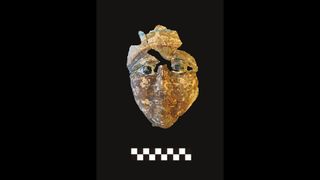
A mummy mask that was discovered by the excavation team at Saqqara. (Image credit: Courtesy of the Egyptian Ministry of Tourism & Antiquities)
Archaeologists in Egypt have discovered a series of tombs dating from about 1,800 to 4,800 years ago, some of which contain colorful mummy masks and even the childlike statue of the god of silence, according to the Egyptian Ministry of Tourism and Antiquities.
The colorful mummy masks, which would have been worn by the dead, probably date to the Roman period (29 B.C. to A.D. 641), according to Nozomu Kawai, the director of the Institute for the Study of Ancient Civilizations and Cultural Resources at Kanazawa University in Japan, who led the excavations.
The archaeologists also found a small statue showing Harpocrates, a Greek god that looks like a child who is associated with silence, riding a goose. The goose represents “an evil spirit over which the Divine Child triumphs,” Kawai told Live Science in an email.
A relief saying that it was created for a man named Heroides. This man was probably buried in the tomb in which it was found. (Image credit: Courtesy of the Egyptian Ministry of Tourism & Antiquities)
The team also found a stela, or a carved stone slab, with writing that states it belongs to a man named “Heroides,” Kawai said.
Related: How old are the Egyptian pyramids?
Kawai and his colleagues originally found some of the burials at this site in northern Saqqara — including the tomb of a “worthy” woman named Demetria depicted in a carving with her pet — in 2019. But the COVID-19 pandemic meant the archaeologists had to suspend their work, Kawai said.
A sarcophagus with a mummy inside. (Image credit: Courtesy of the Egyptian Ministry of Tourism & Antiquities)
When they returned in 2023, they unearthed a number of additional tombs and artifacts. “The area we are excavating is the eastern escarpment of the North Saqqara plateau,” Kawai said. “As far as we have excavated there, the oldest tombs belong to the Second Dynasty,” or to about 4,800 years ago. They also found tombs dating to the 18th Dynasty (circa 1550 to 1295 B.C), the Late Period (circa 712 to 332 B.C.), as well as more tombs and artifacts dating to Ptolemaic and Roman times.
This burial dates back to the Second Dynasty, around 4,800 years ago. It shows a crouching individual within the remains of a wooden box. (Image credit: Courtesy of the Egyptian Ministry of Tourism & Antiquities)
Within one of the oldest tombs at the site, the team found an “Egyptian alabaster plate dating to the Second Dynasty accompanied with a crouching burial inside of a wooden box coffin which was deteriorated by termites,” Kawai said. A tomb dating to the 18th Dynasty had a mummy within a coffin, the Egyptian Ministry of Tourism and Antiquities said in a translated statement.
Saqqara contains vast necropolises, so it’s no surprise that archaeologists have found tombs dating to different dynasties of ancient Egypt.
Live Science contacted a number of experts not involved with the excavation to get their thoughts. Aidan Dodson, an Egyptology professor at the University of Bristol in the U.K., said that more information will need to be released before he can comment on the finds; other Egyptologists had similar opinions.
Excavation and analysis of the tombs is ongoing.
Editor’s note: Updated at 2:17 p.m. EST to clarify that the newfound mummy masks likely date to the Roman period (29 B.C. to A.D. 641).





